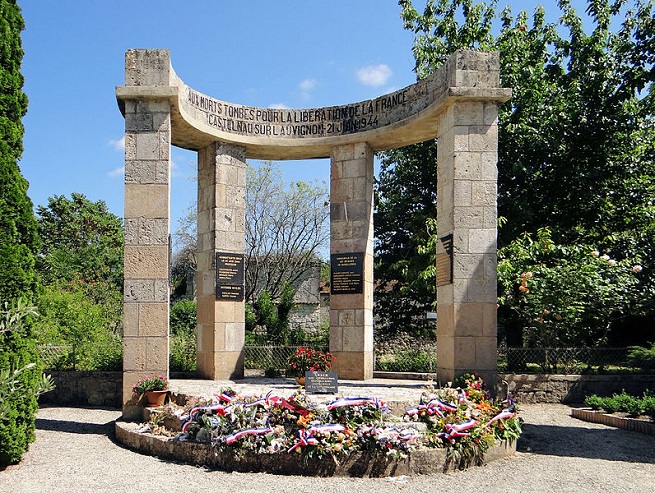History of the Resistance: Exploring Castelnau-sur-l’Auvignon in the Gers
On the pilgrim path of Saint Jacques between Le Romieu and Condom is Castelnau-sur-l’Auvignon, a commune in the Gers department of southwest France. It looks unremarkable at first glance but appearances can be deceptive and, significantly, deception is in keeping with the history of the place. In 1942, Resistance fighters of various nationalities organised themselves in the Gers department. One of those fighters was George Reginald Starr, a British Officer of the Special Operation Executive, or the “Ministry of Ungentlemanly Warfare” as Winston Churchill refereed to the organisation which was formed in response to Churchill’s call to “set Europe ablaze”. Starr established his command post in Castelnou-sur-l’Auvignon.

Castelnau-sur-l’Auvignon, photo: MOSSOT
George Reginald Starr was born in Shropshire, the son of an American father and an English mother. He was educated at Ardingly College in West Sussex. At sixteen years old he was enrolled as an apprentice coal-miner and mine engineer at the Royal School of Mines at Imperial College, London.
Starr was working in Liège, Belgium, when the German forces invaded and he returned to England during the Dunkirk evacuation. He was soon recruited into SOE (Special Operations Executive) for his mining expertise and linguistic skills.

George Reginald Starr. photo: Imperial War Museum
In November 1942, shortly before German forces occupied the Vichy Republic, Starr entered France clandestinely by felucca on the Mediterranean coast. He assumed the persona of a retired Belgian mining engineer who had made his fortune in the Belgian Congo.
Starr, one of the best and most effective secret agents, known as Colonel “Hilaire”, established a network of French resistance groups in southwest France, designated as the so-called “Wheelwright sector” which operated around Bordeaux, Toulouse and the Pyrenees. The networks (reseaux in French) were assigned with gathering information and disrupting the German army. The groups usually contained a minimum of three agents: a network leader, a wireless operator and a courier.
Starr’s wheelwright network was made up of some outstanding and resourceful agents such as Jean Claude Arnault, his wireless operator, Yvonne Cormeau and his couriers, Philippe de Gunzbourg and Anne-Marie Walters.
Anne-Marie Walters, codenamed “Collette,” was described as “intelligent, head strong, quick, practical and cunning” which appear to be ideal attributes for her work as a secret agent. She was brought up in Geneva, the daughter of an English father and a French mother. Walters was recruited by SOE at the young age of nineteen and dropped into southwest France with fellow agent Jean Arnault. Her memoir, “Moondrop to Gascony,” is one of the best accounts of an SOE agents work in occupied France. Walters was awarded the Croix de Guerre and Medaille de la Reconnaissance Francaise. She died on 3 October 1998, aged 75.

Anne-Marie Walters
Yvonne Cormeau, code-named “Annette,” was the daughter of a Belgian consular official and a Scottish mother. After the death of her husband in an air raid, Cormeau, who had survived the bombing when a bath fell over her, was recruited by SOE in 1943. She was dropped onto northeast Bordeaux in 1943 and joined Starr’s team. On one occasion both she and Starr were stopped at a German checkpoint and Cormeau, disguised as a nurse, calmly and coolly talked her way out of arrest by passing off her wireless as an X-ray machine.
Yvonne Cormeau was awarded both the Legion d’honneur and the Croix de Guerre for her activities in occupied France. She died on 25 December 1997, aged 88.
Baron Philippe de Gunzbourg, known as “Edgar” and one of Starr’s most reliable couriers, travelled about the country on a bicycle and it is said he covered more than 15,000 miles during the course of his resistance work.
In late 1944, before the Normandy Invasion, Starr formed the Armagnac group with the intention of disrupting the German army by cutting telephone wires, blowing up railway lines and sabotaging power lines.

Yvonne Cormeau
After the war Starr went to Essen in the Ruhr district to direct the re-opening of German coal mines. He retired to France and died at Senlis in 1980. He was awarded the Legion d’honneur in recognition of his war time exploits.
The town was also the base of the remarkable French resistance fighter Jeanne Robert, a schoolteacher originally from Hanson, a small town close to Maubeuge. She had fled to southwest France to avoid capture by the Gestapo.
On October 17, 1943, Robert, betrayed by an informer, narrowly managed to avoid capture by the Germans who were informed to look out for a “a young woman from the north with blond hair” and was air-lifted out of France to London where she remained as part of Charles de Gaulle’s Bureau de Renseignements et d’Action, returning to France after the liberation of Paris in August 1944.

Castelnau-sur-l’Auvignon, photo: MOSSOT
As a consequence of its harbouring of resistance fighters, the commune of Castelnau-sur-l’Auvignon was burnt to the ground and destroyed by the Germans, hoping to persuade the locals that there was no point in trying to take advantage of the D-Day invasion.
Jeanne Robert died on September 7, 2017, aged 103. News of her death was met with an outpouring of grief and affection in Castelnau-sur-l’Auvignon, where the local primary school is named in her honour.
Related article: Hidden France: Memories of the Resistance in the Gers
Share to: Facebook Twitter LinkedIn Email
Leave a reply
Your email address will not be published. Required fields are marked *





